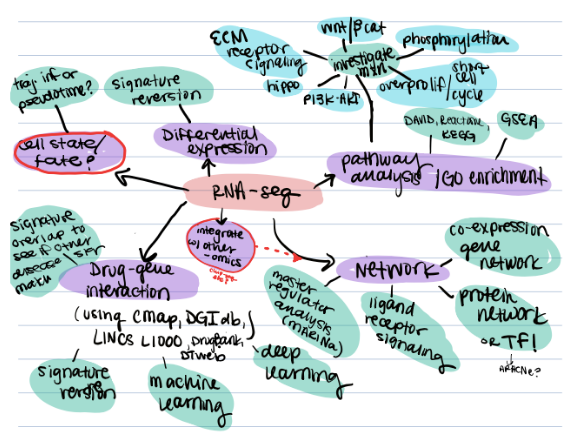Potential SETBP1 Research Avenues using RNA-sequencing Data
Potential SETBP1 Research Avenues using RNA-sequencing Data
Haley Oyler, Erin Otness, Jordan Whitlock
The flowchart above is a comprehensive guide to potential avenues of research using publicly available RNA-sequencing (RNA-seq) data. It outlines the major approaches (depicted in purple) and the downstream analysis methods or topics that could be investigated (in green). Additionally, it includes a list of mechanisms and pathways identified in Cardo et al. 2023 (in blue).
We cannot believe we are nearly halfway through 2024! As we have been reflecting upon groundbreaking research for SETBP1 over the last few years, we took some time as a team to also propose some future areas and directions to focus on looking into the future. Thanks to technological advances and accessibility, genetic sequencing has moved to the forefront of science today. RNA-sequencing (RNA-seq) in particular is an approach that allows scientists to measure gene expression levels to identify which genes are active and to what extent at the tissue and even single-cell level. This data helps researchers understand biological processes, identify disease mechanisms, and develop targeted treatments.
The brainstorming cloud, a visual representation of our team’s ideas, is a testament to the vast potential of RNA-seq data. It hints at the numerous research directions that could be pursued, each promising to uncover new knowledge or build upon the discoveries made using SETBP1-HD RNA-seq.
From this brainstorming cloud, we isolated two areas of research to focus on for our SETBP1 Society Microgrant Program.
Directions to Explore Deeper:
- Phosphorylation in SETBP1
- We know SETBP1 stabilizes SET by blocking protease cleaveage and autophagic degradation therefore allowing SET to associate with PP2A and inhibit phosphatase activity. In a GoF setting this accumulation of SETBP1 affects global phosphorylation, however what happens in a LoF setting?
- We know SETBP1 stabilizes SET by blocking protease cleaveage and autophagic degradation therefore allowing SET to associate with PP2A and inhibit phosphatase activity. In a GoF setting this accumulation of SETBP1 affects global phosphorylation, however what happens in a LoF setting?
- Signature Reversion and Drug-Gene Interaction
- Aside from palliative treatment, there is currently no cure for SETBP1-HD. The standard of care for SETBP1-HD is constantly under improvement as clinicians and patients work together to identify treatments focused on aiding development throughout childhood, alleviating social and behavioral differences, and improving patient quality of life.
Microgrant Details
SETBP1 Society currently is funding microgrants which are intended to fund small proof-of-concept studies aimed at collecting supportive data for subsequent research initiatives and funding. Applicants may request up to $25,000 direct costs to be expended within a 12-month period.
SETBP1 Society does not support indirect costs for Grants.
Deadlines
- Current Deadline for Letter of Interest (LOI): August 2nd, 2024
- Notification of LOI Acceptance by August 9th, 2024
- Current Deadline for Full Application: September 16th, 2024
- Grant Award Announcement by October 25th, 2024
Learn more about the SETBP1 Society Microgrant Program!
